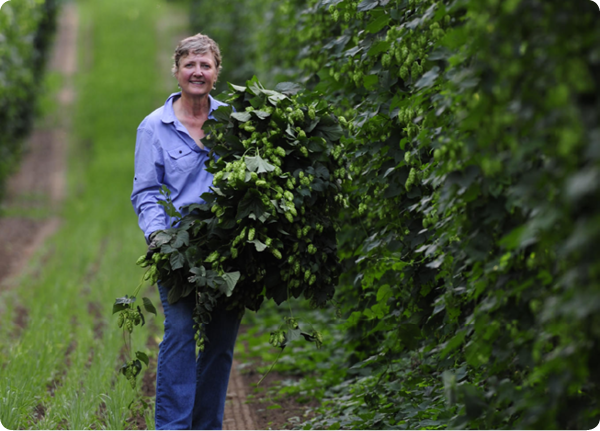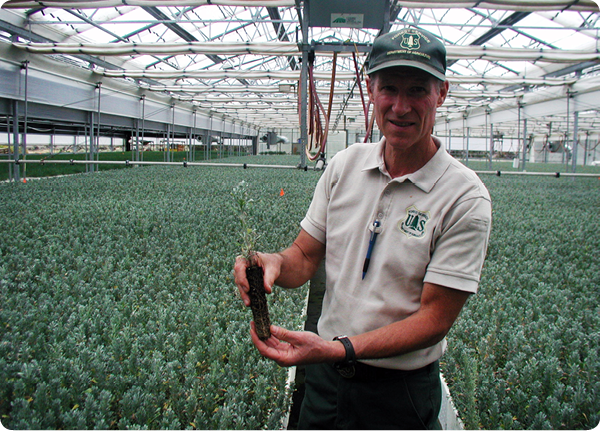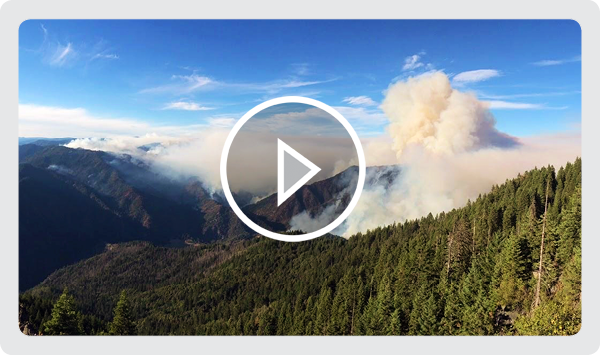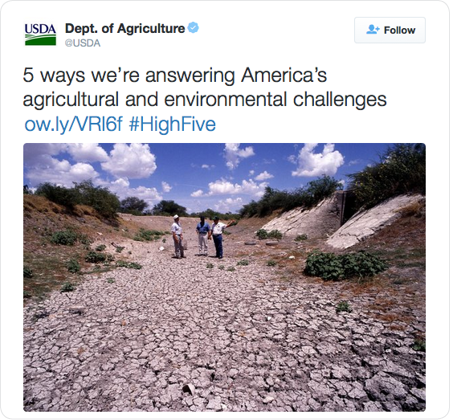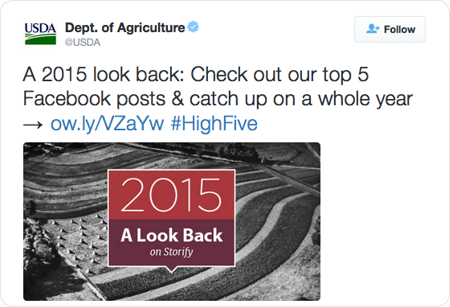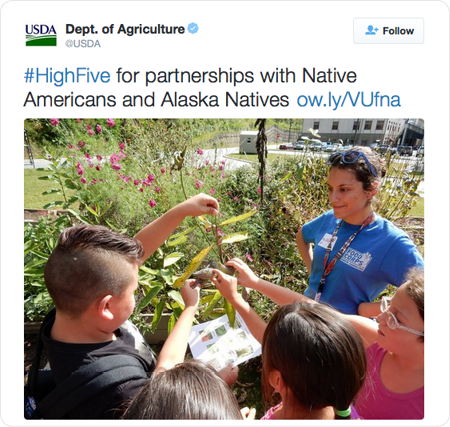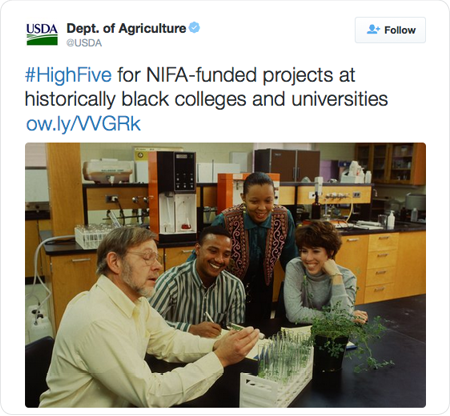Having trouble viewing this email? View it as a Web page.

With the world’s population expected to grow to between 9 and 10 billion by 2050, some experts have estimated that to meet the growing demand for food, it will take as much innovation in agriculture in the next 40 years as in the preceding 10,000 years. To take this on, we will need a diverse and educated set of leaders empowered to meet ever-emerging challenges that threaten the productivity and profitability of our farms, ranches and forests. That's why this week our high five feature is Dr. Lois Wright Morton, whose passion for climate change research stemmed from growing up on a farm in northeast Ohio. Dr. Morton’s research focuses on the relationship between people and the natural environment as it relates to climate change. Today, Dr. Morton is leading research efforts nationwide that will give farmers and ranchers the management tools they need to deal with a changing climate. Read a Q&A with Dr. Morton on the impact research has on women worldwide and how the field continues to evolve. As 2015 draws to a close, we’re thanking our nation’s farmers and ranchers for all they’ve done by highlighting a few of the most moving and motivating stories of the year. Follow along this month as we continue to feature farmer and rancher stories as well as track some of our favorite digital content from 2015. Throughout December, use #highfive to see just what we’ve been up to in the last 12 months, and stay tuned as we look forward to a 2016 that promises to be better than ever.
High Five for NIFA-Funded Projects at Historically Black Colleges and Universities As we look back on 2015, NIFA is also celebrating the partnership we have developed with the nation’s land-grant universities (LGUs), who play a critical role teaching students to meet the high quality, innovative research needs that are vital to the production of our country’s food, fuel, and fiber. High Five for Partnerships with Native Americans and Alaska Natives 2015 was another banner year for innovative Federal / Tribal partnerships, government-to-government relations with Federally Recognized Tribes and investments that continue to improve the quality of life for American Indians and Alaska Natives. Here are five examples from this past year of ways USDA and this Administration have built on their deep commitment to improving our working relationships with Tribes and helping them meet unique challenges facing tribal communities head-on. In 2015, we’ve seen agriculture and natural resources at the crossroads of the world’s most critical problems: establishing sustainable food production, providing clean and abundant water, responding to climatic variability, developing renewable energy, improving human health, and strengthening food safety. High Five for Pollinators: Busy Bees, Bats and Butterflies Day and night, pollinators are at work all around us—and it’s not just honey bees. Did you know that pollinators are responsible for one out of three bites of food we eat? If you’d like to learn more, we’ve pulled together five blogs from 2015 highlighting some surprising facts about these busy helpers and the many ways different USDA agencies, farmers, ranchers and other partners are working to keep all pollinators healthy. Protecting Sage Grouse for Future Generations… One Seed at a Time The need for food and shelter for wildlife to survive is basic, particularly for sage grouse living in a post-wildfire landscape in western states. The U.S. Forest Service is helping this upland game bird survive by growing about 3 million sagebrush shrubs a year to restore the area’s dry, grassy plains, essential for the bird’s nesting grounds. Deck the Halls with Holiday Data From the smell of fresh pine, to the vibrant colors of poinsettias, the holiday season is the perfect time of year to spotlight America’s horticulture growers through the just released 2014 Census of Horticultural Specialties report. The Chugach Children’s Forest is Transforming Lives for Future Generations “If you were to tell me three years ago that in two years, I would be camping a couple feet away from a glacier and kayaking next to icebergs, I would tell you that you are out of your mind,” said Isabel Azpilcueta. But life takes us in unexpected directions, and that is exactly what Isabel – a Chugach Children’s Forest alumni – found herself doing during a Habitat Restoration Kayaking Expedition on the Chugach National Forest, in Alaska. In Conversation with #WomeninAg: Dr. Lois Wright Morton As part of our ongoing #womeninag series, we are highlighting a different leading woman in agriculture each month. This month, we profile Dr. Lois Wright Morton, professor of sociology in the College of Agriculture and Life Sciences at Iowa State University and director of the USDA-NIFA Climate & Corn-based Cropping System Coordinated Agricultural Project. Saving Our Forest Heritage in a Vault Trees are often referred to as the lungs of the earth, providing not only the oxygen we need to breathe but a filter to clean our air and water. Trees from forested lands provide timber for our homes, food for people and wildlife, protection from weather extremes and, in urban and rural settings, beautify cities and landscapes alike. Where Passion Meets Purpose: The Snow Survey “To say I enjoy my job is an understatement,” said Hydrologist Randy Julander. “Monday is my favorite day of the week, because I get to go back to work.” As the Snow Survey Data Collection Officer in Utah, Julander’s job is a mix of science, adventure and artistry. He weaves information from data. “Data are just numbers on a page; but information – now that’s something meaningful, something that informs decision makers,” he explained. Forest Service Teams Help in Aftermath of Historic Flooding in Tbilisi, Georgia Last summer, after a flash flood swept through Tbilisi, the capital of the nation of Georgia, the U.S. Forest Service deployed three teams to help address some of the most critical challenges. The horrific event killed 19 people, forced 67 families from their homes, destroyed roads, and flooded the city zoo. Most of the animals died and the surviving animals wandered the city’s streets.
We continue our look back at 2015 and looking ahead to 2016.
What the Global Climate Change Agreement Means for U.S. Farmers. Broadcast Date: Mon, December 14, 2015 The world's nations have a new global climate change agreement. What does this mean for U.S. farmers? (Gary Crawford, Bill Hohenstein, President Barack Obama and Laurent Fabius) Actuality: Farmers Will Benefit from More Climate Related Conservation Work Broadcast Date: Mon, December 14, 2015 Bill Hohenstein, Director of USDA's Climate Change Office, saying that the farm conservation practices needed to mitigate climate change also will improve farmers' bottom lines. Actuality: Agreed Actions under Paris Agreement Won't Halt Climate Change Broadcast Date: Mon, December 14, 2015 Bill Hohenstein, Director of USDA's Climate Change Office, saying that the actions resulting from this Paris Climate Change Agreement alone will not halt or reverse global climate change, but it's a start of a long process. Process Verified Explained To Consumers Online Broadcast Date: Mon, December 14, 2015 A USDA program designed to help food and ag companies differentiate their production and products is receiving some promotion through a revamped website and social media. (Rod Bain and Agricultural Marketing Service Deputy Administrator Craig Morris) Highlights From 2014 Census Of Horticulture Broadcast Date: Mon, December 14, 2015 The latest edition of a USDA survey on horticulture and specialty crops reveals increases in both sales and number of operations. (Rod Bain and Lance Honig of the National Agricultural Statistics Service) The Structure Of US Horticultural Operations Broadcast Date: Mon, December 14, 2015 2014 Census of Horticulture gives the breakdown of family farms versus corporations, and their sales. (Rod Bain and Lance Honig of USDA's National Agricultural Statistics Service) Huge National Farm Conservation Survey Now Going On Broadcast Date: Mon, December 14, 2015 Thousands of farmers from all over the country are being interviewed about their conservation efforts for a two year project. (Gary Crawford and Ty Tolbert)
Vilsack says COP21 deal helps make world more food-secure (Brownfield Ag News) U.S. ag secretary Tom Vilsack says the historic COP21 deal will help make the world more food-secure. 15 Minutes with USDA Secretary Tom Vilsack (Modern Farmer) What would you ask the Secretary of Agriculture if he offered you 15 minutes of his time? THE RISING TIDE OF FEMALE FARMERS (Daily Yonder) The story of Donna Schroeder’s life until now—she is 76—can be told with chicken scratches carved into a small wooden block, an engraving that hangs amid dozens of others just like it in Elmo’s Highwood Bar in Highwood, Montana. USDA Takes Climate Change Conversations To Colorado Farmers (Colorado Public Radio) Negotiators are hoping to wrap up a deal at the Paris climate talks this weekend. But reaching an agreement just the first step -- leaders and policymakers must then sell the plan to the people. More money to fight wildfires, but no long-term budget fix Budget legislation headed toward approval by Congress includes an additional $610 million for the U.S. Forest Service to fight wildfires next year but no long-term fix to how the agency, year after year, has had to borrow money from other programs to keep up with the ever-growing cost of fighting fires. My Holiday Wish List for America’s School Children As this year is coming to an end, I’ve been reflecting on the state of school food: the good and the bad. Urban jungle: wooden high-rises change city skylines as builders ditch concrete (The Guardian) The concrete jungle has a rival: forests. Two urban building projects, in New York City and Portland, Oregon, will be changing their city’s skylines with an environmentally sustainable, cost-competitive building material. The key ingredient? Wood.
|



